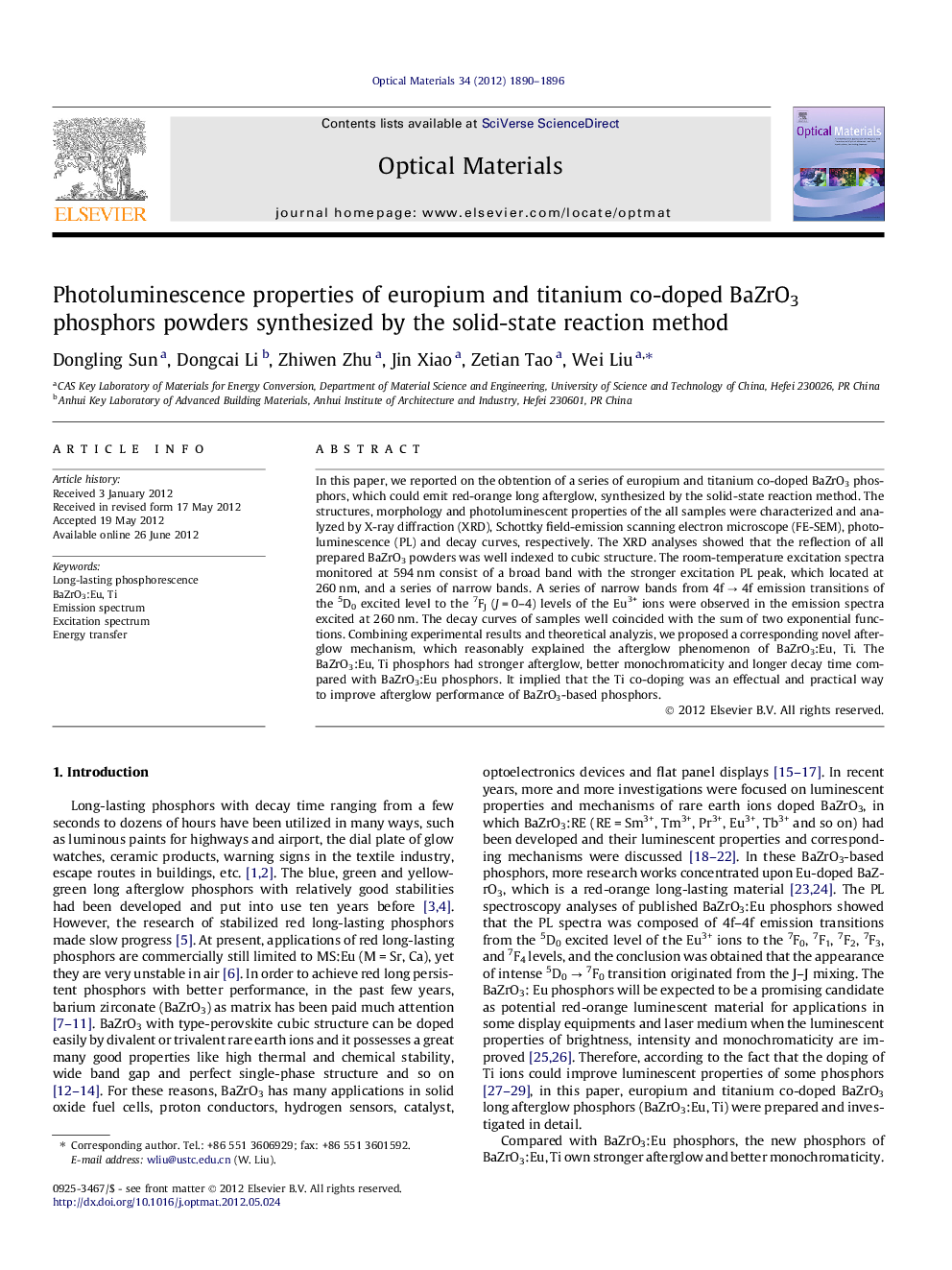| کد مقاله | کد نشریه | سال انتشار | مقاله انگلیسی | نسخه تمام متن |
|---|---|---|---|---|
| 1495472 | 992936 | 2012 | 7 صفحه PDF | دانلود رایگان |

In this paper, we reported on the obtention of a series of europium and titanium co-doped BaZrO3 phosphors, which could emit red-orange long afterglow, synthesized by the solid-state reaction method. The structures, morphology and photoluminescent properties of the all samples were characterized and analyzed by X-ray diffraction (XRD), Schottky field-emission scanning electron microscope (FE-SEM), photoluminescence (PL) and decay curves, respectively. The XRD analyses showed that the reflection of all prepared BaZrO3 powders was well indexed to cubic structure. The room-temperature excitation spectra monitored at 594 nm consist of a broad band with the stronger excitation PL peak, which located at 260 nm, and a series of narrow bands. A series of narrow bands from 4f → 4f emission transitions of the 5D0 excited level to the 7FJ (J = 0–4) levels of the Eu3+ ions were observed in the emission spectra excited at 260 nm. The decay curves of samples well coincided with the sum of two exponential functions. Combining experimental results and theoretical analyzis, we proposed a corresponding novel afterglow mechanism, which reasonably explained the afterglow phenomenon of BaZrO3:Eu, Ti. The BaZrO3:Eu, Ti phosphors had stronger afterglow, better monochromaticity and longer decay time compared with BaZrO3:Eu phosphors. It implied that the Ti co-doping was an effectual and practical way to improve afterglow performance of BaZrO3-based phosphors.
The emission spectra of BaZrO3:Eu0.025, Tix (x = 0, 0.005, 0.015, 0.025, 0.035, 0.045) phosphors (λ = 260 nm) (I) and the relationship point diagram of Ti doping amounts and emission intensity of 594 nm (II). From this Fig. it can be seen that the luminescence intensity caused by the transition of 5D0 → 7F1 of the Eu3+ becomes stronger with the increase of Ti ions concentration when the Ti doping amount is less and the maximum of luminescence intensity is reached when the Ti doping molar fraction is 1.5%. Compared with BaZrO3:Eu0.025 phosphors, the luminescent intensity of BaZrO3:Eu0.025, Ti0.015 is improved six times or so. When x exceeds 0.015, the luminescent intensity of BaZrO3:Eu0.025, Tix weakens, which is probably due to occurring concentration quench by the cross relaxation of neighboring Ti3+ ions. However, the luminescence of the Eu3+ transition of 5D0 → 7F0 becomes weaker with the increase of Ti concentration, this luminescence intensity is barely detectable when Ti molar fraction is up to about 3.5%. Compared with BaZrO3:Eu phosphors, BaZrO3:Eu, Ti phosphors have stronger afterglow, better monochromaticity.Figure optionsDownload high-quality image (113 K)Download as PowerPoint slideHighlights
► We prepared new red-orange long-lasting BaZrO3:Eu, Ti phosphors for the first time.
► This phosphor has stronger afterglow, better monochromaticity and longer decay time.
► A series of novel luminescence phenomena of this phosphor were discovered.
► The corresponding afterglow mechanism of this phosphor was proposed and discussed.
Journal: Optical Materials - Volume 34, Issue 11, September 2012, Pages 1890–1896